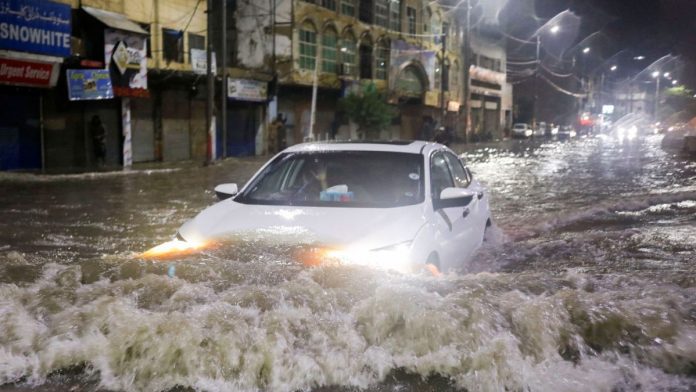Pakistan’s largest city battered by torrential rain as climate crisis makes weather more unpredictable

A vehicle drives along a flooded street following heavy rains during the monsoon season in Karachi, Pakistan July 24, 2022.
Islamabad, Pakistan (CNN)Public services in Pakistan’s largest city, Karachi, have been suspended and businesses are being urged to close, as torrential rains cause deadly flash flooding and infrastructure damage, leaving at least 15 dead since Saturday.
On Sunday night, more than 60 millimeters (2.3 inches) of rain fell in Karachi, equivalent to an entire months’ worth of rainfall in just a matter of hours.
For several months every summer, Pakistan struggles to contend with heavy monsoon rains, but in recent years experts say climate change is accelerating existing weather patterns.
On Sunday, Pakistan’s climate change minister, Sherry Rehman, issued flash flood warnings for residents in more than 14 cities and townships.
Since the monsoon season began last month, more than 300 people have been killed by heavy rains across Pakistan, according to its National Disaster Management Authority.
In Karachi, capital of Sindh province and home to almost 16 million, entire neighborhoods have been partially submerged. Photos show people wading knee-deep in muddy floodwater, with vehicles left stranded by the deluge.
Infrastructure including bridges, highways and roads have been damaged, disrupting traffic and upending the lives of millions across the city. Many have stocked up on fuel for their generators in case of power outages.
“Climate change is a threat. We are a coastal city. It’s happening so fast and we will bear the brunt,” said Afia Salam, a climate change advocate in Karachi. “People need to see the situation beyond individual events like a bridge falling or a road getting flooded.”
Climate crisis and poor infrastructure
Pakistan often experiences heavy rains from July through September, but experts say the rains have only increased in both frequency and intensity.
“The rapidity of these events is increasing and our response is not keeping pace,” said Salam. “We are being reactive to individual events. Strategies need to be put in place.”
And the poorest and most vulnerable are on the front line of crisis.
Karachi, the country’s financial capital, boasts luxury hotels, malls and upmarket gated communities. But disparities in wealth and development remain, and an estimated 50% of its residents are “forced to live in informal settlements,” according to the World Bank.
“Karachi’s infrastructure is highly vulnerable to climate-related disasters,” according to the World Bank.
The crisis is exacerbated by poor flood management and ineffective disaster response, experts say.
Other provinces, including Balochistan in the southwest, have also experienced extreme rainfall in recent days. At least 87 people have been killed in the province due to “heavy rainfall, floods and infrastructure collapse” this month alone, according to a report from the Provincial Disaster Management Authority (PDMA).
Two people — a woman and a child — died on Sunday after a roof collapsed in the province’s Jaffarabad district, according to Naseer Nasar, PDMA director general.
At least eight dams in Balochistan have been breached, while nine bridges have been damaged, the PDMA report said. More than 700 livestock have died due to flooding, it added.
Earlier this month, torrential rain caused widespread flooding in Karachi. Most underpasses were flooded, and there was nowhere to pump the water out to, according to the chief minister of Sindh, Murad Ali Shah.
Karachi’s main streets, which house financial institutions and bank headquarters including Pakistan’s central bank, were flooded and rescue services were using boats to reach stranded people.
Extreme weather impacts millions
Extreme weather events in South Asia are becoming increasingly frequent due to climate change, with temperatures in parts of India and Pakistan reaching record levels during a heat wave in April and May.
A deadly cholera outbreak linked to contaminated drinking water had infected thousands of people in central Pakistan in May, as the country grappled with a water crisis exacerbated by the scorching temperatures.
Residents in Pir Koh, a remote mountainous town in Balochistan province, had no access to clean drinking water. The lack of rain had caused nearby ponds to dry up, with their only source of water being a pipeline that had “rusted and contaminated the water supply,” said local resident Hassan Bugti.
A 2022 report by the Intergovernmental Panel on Climate Change (IPCC) said they had medium confidence that heat waves and humidity stress would become more “intense and frequent,” and “annual and summer monsoon precipitation will increase.”
India and Pakistan are among the countries expected to be worst affected by the climate crisis, according to the IPCC.











